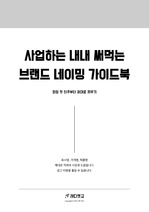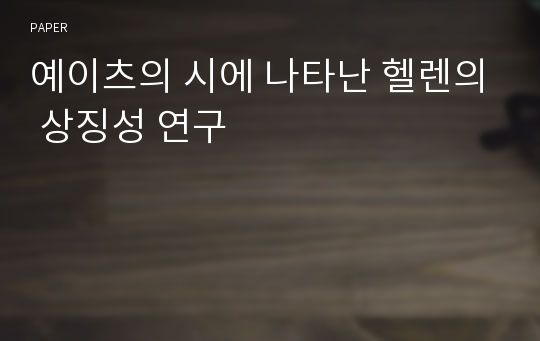* 본 문서는 배포용으로 복사 및 편집이 불가합니다.
서지정보
ㆍ발행기관 : 한국예이츠학회
ㆍ수록지정보 : The Yeats Journal of Korea / 13권
ㆍ저자명 : 조미나
ㆍ저자명 : 조미나
영어 초록
Yeats presented the fallen majesty of Sophia who is a veiled goddess as in Valentinian of Christian Gnosticism, Cabalism and Rosicrucianism. In this respect, Yeats himself rejected the masculine Trinity and insisted on an androgynous Trinity throughout his works. Yeats’s view of Sophia is that of Attis for goddess Cybele. Yeats sought to reveal that Daughter-Sophia was a fallen Deity such as Helen of Troy or Cinderella and Sleeping Beauty of the fairy tale. Therefore one of Yeats’s major poetic themes is the longing for Sophia. From his early poems, Helen is symbolized as Sophia’s secular image and as one of the Yeats’s personal poetic heroines. Yeats wanted Helen, the cause of Troy’s fall, compared to Sophia who was the cause of the Christian’s fall for early Christian Gnostics. Also, several of Yeats’s poetic heroins can be approached in terms of Sophia’s secular and mournful beauty who is suffering with mankind in this world. Especially, Yeats as a master myth-maker himself recreated Helen as his personal unique mythic character in Sophia’s image. For Yeats, Maud Gonne’s poetic role was the embodiment of Ireland as Rose, Helen, Cathleen, Deirdre, Niamh and Jane. These figures are all symbolized as a divine Feminine Principle existing within the God, Masculine Principle before the all creation. And Yeats lays himself and the world at her feet as the love poet or her sole priest just as did Attis for Cybele. Yeats’s personal and poetic heros as symbols of Yeats’s portraits: Attis, Homer, Jester, Oisin, Red Hanrahan, Fergus, Cuchulain, and Aleel. Through Sophia’s imagery, Yeats suggested gnostic speculations about the female elements of divinity, rigorously suppressed by the orthodox Christian fathers of the early church, and this rejection remains to this day. In other words, Yeats tried to carry out a poetic recovery of one single body work of art from the veiled goddess, Sophia. Because Yeats wanted to become Sophia’s sole priest, Valentinian. His hope appears in his poetic theme of a ‘Unity of Being’ by uniting with Sophia after his own death and Sophia’s death too. In this sense, Yeats often illustrated in his poems sorrowful love and an eagerness for the death of the beloved. This idea and sentiment is seen in Aleel’s attempted unity with Cathleen: Aleel suggests Countess Cathleen who is suffering with her people go to Heaven to escape her pains. Although people mocked Yeats’s attitude regarding Sophia, he envisioned a heroic dream in which Sophia will be revealed with her Heavenly power in a future as her era comes. And at last, she will recover her genuine glory in Heaven. Sophia’s era will come 2000 years after Christ’s birth according to Yeats’s unique historical view. For example, “Leda and the Swan” and “A Nativity” symbolize the coming of the masculine Trinity era with in the Orthodox Church. So Yeats stated when the Christ or Helen or Christ’s sister (Daughter-Sophia) was born, the Mother of God, Mary or Leda was frightened and terror-struck. Therefore Helen symbolized secular beauty suffering with mankind during the 2000 years of the masculine Trinity age. On the other hand, in “The Second Coming,” Yeats suggested that Sophia’s veil be removed when she recovers her glory. The terrible Sphinx stands for this coming of Sophia, which will establish an androgynous Trinity just as seen in the Egyptian Trinity: Osiris, Isis and Horus. Sophia as Yeats’s beloved is also symbolized by the Sphinx, ‘half lion, half child’ in “Against Unworthy Praise.” Thus we see Yeats endeavoring to draw the readers’ attention to the stress laid by feminine principle, Helen-Sophia who is with mankind as Countess Cathleen -with sacrificial love and her suffering under the masculine Trinity- until the new age comes, which was stated as ‘until coming sphinx’ or ‘until God burn time.’ So Yeats was an authentic prophet in our time.참고 자료
없음"The Yeats Journal of Korea"의 다른 논문
 Review: Yeats's Poems Set to Music4페이지
Review: Yeats's Poems Set to Music4페이지 탈식민주의 담론과 과거 들춰내기: W. B. Yeats의 시에 나타난 탈신화적 전략36페이지
탈식민주의 담론과 과거 들춰내기: W. B. Yeats의 시에 나타난 탈신화적 전략36페이지 Death and Metaphor in Yeats’s Poetry17페이지
Death and Metaphor in Yeats’s Poetry17페이지 매스크와 크루소 ― 데릭 월콧(Derek Walcott 1930∼ )과 윌리엄 버틀러 예이츠(Wil..33페이지
매스크와 크루소 ― 데릭 월콧(Derek Walcott 1930∼ )과 윌리엄 버틀러 예이츠(Wil..33페이지 윌리엄 예이츠와 셰이머스 히니의 시에 나타난 아일랜드 카톨릭 민족주의: 종교적 정체성의 문제23페이지
윌리엄 예이츠와 셰이머스 히니의 시에 나타난 아일랜드 카톨릭 민족주의: 종교적 정체성의 문제23페이지 아일랜드 상징으로서의 여성상: 『캐스린 니 훌리한』과『디어드르』를 중심으로22페이지
아일랜드 상징으로서의 여성상: 『캐스린 니 훌리한』과『디어드르』를 중심으로22페이지 Yeats와 Eliot의 문학적 상상과 종교적 상징 ― “The Magi”의 수사학을 중심으로 ―25페이지
Yeats와 Eliot의 문학적 상상과 종교적 상징 ― “The Magi”의 수사학을 중심으로 ―25페이지 Reading Yeats’s Two Early Poems, “The Ballad of Moll Ma..9페이지
Reading Yeats’s Two Early Poems, “The Ballad of Moll Ma..9페이지 예이츠의 시에 나타난 성: 「젊었을 때와 늙었을 때의 여자」 읽기29페이지
예이츠의 시에 나타난 성: 「젊었을 때와 늙었을 때의 여자」 읽기29페이지 W. B. 예이츠의 극시 『메이브 여왕의 노년』 연구27페이지
W. B. 예이츠의 극시 『메이브 여왕의 노년』 연구27페이지

























